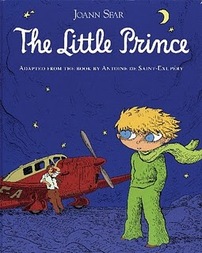 The little prince by Joann Sfar, adapted from the book by Antoine de Saint-Exupéry
Houghton Mifflin, 2010
A man is stranded in the desert with a broken-down airplane. He is asleep one night when the little prince awakes him with a request: "Please. Draw me a sheep." Thus begins a friendship between a human and a small alien boy who wants to return to his home planet and the flower that he loves.
Sfar's graphic adaptation of the classic book by de Saint-Exupéry is very faithful to the original text. True, the entirety of the text is not included, but many of the conversations, the planets that the little prince visits, and details like the drawings that the man does are the same. I haven't done a strict adaptation-to-original comparison, but a quick skim through de Saint-Exupéry's book indicates that the essence of his tale is contained in Sfar's work.
The little prince looks quite a bit different in Sfar's adaptation: he has huge eyes and a football-shaped head. The tousled blond hair and scarf remain the same, but Sfar's version of the little prince is more alien-looking than de Saint-Exupéry's. Of course, the little prince is an alien, and his appearance grew on me throughout the book and now I can hardly picture him otherwise.
Sfar's style of illustration is distinctive. There is an informal, almost sketch-like quality to his drawings, such as scribbles to indicate texture on the ground. I'm not sure if there is an actual straight line in the entire book, but the drawing are anything but haphazard. The angles Sfar uses, especially on the planets that the little prince visits, vary widely and give a sense of the space and atmosphere at each planet. I found his interpretations of the aliens and other characters strange and fascinating, especially the king on the first planet with his elephantine nose and the fox on Earth whose ears look identical to his fluffy tail. Admittedly, Sfar's style took a few pages for me to get used to, but I ended up really liking it.
While not a replacement for Antoine de Saint-Exupéry's work, Sfar's graphic novel adaptation of The little prince is a lovely introduction to or a lovely reminder of a timeless story that holds a spot in many hearts.
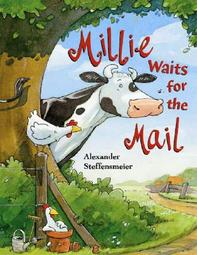 Millie waits for the mail by Alexander Steffensmeier
Walker, 2007
Millie the cow loves scaring the mailman, so she hides in a wide variety of places to wait for him to come down the lane on his bicycle. Unfortunately, she's so good at scaring him that everything the farmer gets delivered is broken. What on earth are the farmer and the mailman going to do to solve the problem?
Originally published in Germany, Millie waits for the mail is a hilarious picture book by premise alone (a cow scaring the mailman? Aren't books usually about dogs doing that?). The illustrations are colourful and full of fun details, especially the chickens partaking in a wide variety of activities in the background, from catching a lift on the tractor with their coffee to wandering about porting a sling and a neck brace. Steffensmeier excels at conveying motion and sound when Millie scares the life out of the mailman: I can almost hear a frantic, bellowed "mmooooOOOOOOOOooo!!" coming out of the page, to say nothing of the mailman's terrified reactions.
Despite the imagined mooing, Millie is actually very doglike - a montage of her hiding places include her in a dog's play pose with her hind end in the air, and when she is taken aback her tail bristles and she strongly resembles a pointer in mid-hunt. Her visible emotions run the gamut from impatience to disappointment to confusion, all conveyed with few differing details by Steffensmeier: just different angles, eyebrows, and body language. I'd also like to note that the farmer is a woman, which I found refreshing.
Millie waits for the mail is an amusing book that stands up to multiple readings, which I know because I regularly grab it off the shelf for a guaranteed giggle.
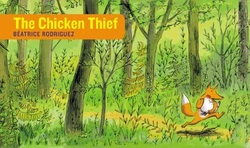 The chicken thief by Beatrice Rodriguez
Enchanted Lion Books, 2010
When a hen is snatched from the farmyard by a fox, a rooster, a bear and a rabbit follow in hot pursuit. The chase lasts for 3 days, through the forest and across the sea, before the fox is finally tracked to his home in a tree trunk.
What an odd little book this is! Even its dimensions - the book stands about 5" high and is approximately 9" long - are different from the usual picture book. This wide perspective lends itself very well to the chase, with the fox and hen on the right side of the page and the pursuers on the left, and the scenery can be shown in detail. The animals are also evocative and drawn with a sense of humour, from the hen's sunglasses to the rooster swooning to any number of eyebrows found throughout. The scenes that involve sunrises and sunsets are especially spectacular, with the quality and colour of the light spot-on.
The chicken thief is told entirely without words, but there are nonetheless some complex feelings addressed. The rooster appears to be the ringleader among the pursuing trio, for although he sometimes leaves the more arduous tasks like burrowing into holes and rowing to his companions, he has the most evident emotional reaction at the end of the story. You see, the hen chooses to stay with the fox to (hopefully) live happily ever after. Yes, the hen and the fox appear to fall in love which seems to be a bit of a stretch, given the usual nature of foxes and hens. On the other hand, who could possibly resist a nice game of chess in a cozy burrow, natural predator or not?
A little bit odd, a little bit humourous, and whole lot of fun.
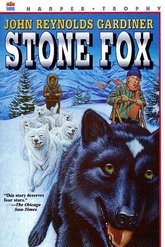 Stone Fox by John Reynolds GardinerScholastic, 1980Ten-year-old Willy and his grandfather run a small farm just outside Jackson, Wyoming. One day, Grandfather wouldn't get out of bed and wouldn't talk. Doc Smith insisted nothing was physically wrong with him but that he had given up, and neither Doc nor Willy knew why. For the next few months, Willy takes care of Grandfather and the farm with his beloved dog Searchlight by his side. When a tax collector shows up and insists that they pay him $500 or the farm will be taken away, Willy must figure out a way to get that money. A local sled race looks to be the best bet, and a very large gamble it is. I read a blog post on the first day of the Iditarod a few weeks ago, and this book was reviewed as a great example of a dog race story. I checked the elementary library and it was there, so I snatched it up and finally read it last night. The review I read was correct: this is a superb dog race story. But it is far more than a book simply about a dog race, as I hope my above synopsis indicates. Willy is a remarkably capable young boy who not only takes care of himself and his grandfather by cooking meals and tending the fire but harvests the potato crop, sells the potatoes, purchases provisions for the winter, and attends school, all of which he takes in stride. Granted, this book is set at an indeterminate point in the past - probably around the turn of the 20th century - when rural children had many responsibilities from a young age, but his determination and independence is no less impressive. The title of the book is taken from the name of Willy's main competitor in the dog race, a First Nations man of seemingly incalculable height who has never lost a race and never speaks. Although the word Indian is used to describe Stone Fox (likely due to the book being written 30 years ago), I appreciated the brief description of his use of his winnings to purchase land for displaced members of his Shoshone people to live on. The correlation between his motivation to win and Willy's motivation to win was not lost on either of them. Ah, Searchlight. Searchlight, Searchlight, Searchlight. Why do I keep reading books that make me want a dog? I don't have room, I'm not a fan of fur or drool, and vet bills would have me owing terrifying amounts of money to Visa. But geez, do I ever want a dog like Searchlight! She's so devoted to Willy that she waits for him all day outside his school and she adores racing home through the woods. I mean, who wouldn't want a dog that could haul you a few miles home while you rode a dog sled behind them? Going dog sledding is on my bucket list though, so perhaps it is just me. Gardiner packs a lot of heart into 81 pages. Great story, great characters (both human and dog), and great ending.
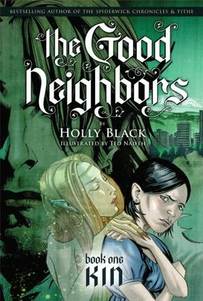 Kin (The good neighbors, book 1) by Holly Black (text) & Ted Naifeh (art)
Graphix, 2008
Rue's mother has been missing for three weeks and her professor father is becoming increasingly distant. Rue is struggling to live a reasonably normal life - going to school, hanging out with her friends - and ignore the strange creatures she keeps seeing. When her father is accused of murdering a young woman, Rue tries to get to the bottom of what really happened to the young woman as well as her mother, and finds far more than she bargained for.
I've been a fan of Holly Black since reading both The Spiderwick Chronicles and Tithe a few years ago, and Kin certainly reinforced to me her interest in and ability to write about humans (and people who initially believe that they are human) encountering the faerie realm. I have to say that I enjoyed both Tithe and The Spiderwick Chronicles more, however, and I'm having trouble putting my finger on why.
Naifeh's art, for one thing, is stunning. The style of both the drawing and the characters is distinctive, and the atmosphere is dark yet not particularly ominous. Rue's expressions and body language are exquisite, both of which lent meaning to her words. I also enjoyed the use of different perspectives and panel layouts throughout the book, and I appreciated how items seen early in the story turned up in a more significant way later on.
The story is more ominous than the drawings, and there is a sense of everything being not quite as it seems from the very beginning. Rue's character was well developed but Rue's parents played very little role other than causing plotting to happen, and I didn't have a sense of them as personalities. It seemed that way with many of the characters, but I'm hesitant to jump to that conclusion seeing as this is the first book in a series. Nonetheless, it felt to me as if Rue was the only "real" character in the book.
To be clear, I don't dislike Kin: it's gorgeous to look at and I am curious to see what's in store for Rue. I will seek out the sequels in the hopes that I enjoy them more.
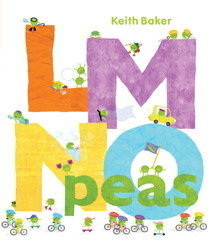 LMNO Peas by Keith Baker
Beach Lane Books, 2010
According to LMNO Peas, peas are far more diverse than I had ever thought. From acrobats to zoologists, peas embark on activities and professions from A to Z.
This is about as adorable as a book can get with rhythmic rhyming text and lovely detailed digital illustrations. Giant letters (well, giant compared to the peas) provide backdrops to peas participating in various activities that start with the corresponding letter. The peas themselves are delightful - the a hiking pea is in the process of losing a hat and each parachuting pea had a different outfit on, to name only two examples - and lots of time could be spent looking at all the hundreds of different peas in the book.
While this has worked well for me as a class read-aloud, I think it would be best read to an individual or small group due to the detail in the illustrations that would be difficult to see from a few feet away. Each and every page has a lot to look at, and the humourous touches for the adult audience (a pea Elvis as a king, anyone?) are also appreciated. Charming all round.
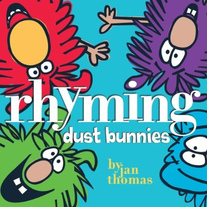 Rhyming dust bunnies by Jan Thomas
Beach Lane Books, 2009
Ed, Ned, Ted, and Bob are four dust bunnies who love to rhyme, and what could possibly interrupt such fun? Bob sees something that might stop their game in its tracks, but whether the other three will listen to what he is saying remains to be seen.
Rhyming dust bunnies is one of my favourite early-elementary books. The illustrations are big and bright in primary and secondary colours, it encourages crowd involvement with the rhyming (what 4- or 5-year-old can resist the question "what rhymes with cat?"), and the plot is ridiculously simple and cleverly executed. Who would have guessed that a book about dust bunnies avoiding a broom could be so funny? Not I.
Thomas creates wonderful tension with Bob, the dust bunny who can't seem to make a rhyme from even the easiest of words. His three friends certainly let him know that his rhyming is not up to par, even when what Bob is saying is, "LOOK OUT!" The audience knows something is amiss from the beginning, and the fun is waiting to see how long it takes Ed, Ned, and Ted to figure it out.
I can attest from personal experience that young children adore this book. When I read it to the grade Primary class last year, they yelled out rhyming words, laughed at the punchlines, and ultimately enjoyed it so much that they demanded I read it again immediately. So I did, and they relished it as much or more the second time. It is a popular book in the library, as it should be.
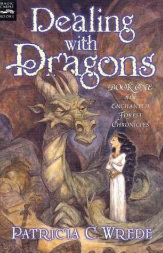 Dealing with Dragons (Enchanted Forest Chronicles - book 1) by Patricia C. WredeMagic Carpet Books (Harcourt), 1990Cimorene is the youngest of the King of Linderwall's seven daughters, and she hates being a princess. In order to avoid royal life and marrying a prince she considers dull, Cimorene volunteers to become a dragon's princess. Although traditionally princes save princesses who have been taken by dragons, Cimorene relishes the relative freedom and becomes caught up in a plot involving wizards, dragons, and a magic stone. Cimorene is a character that might result when the Paper Bag Princess got a little bit older: brave, smart, independent, and with no interest in being rescued by a prince. Cimorene is also perceptive and witty, and I liked her a lot (I imagine it would be quite difficult to dislike Cimorene). I found the vast majority of the characters to be entertaining and consistent, from Alianora to Kazul. Even Moranz was fun. In fact, the my entire experience with Dealing with dragons can be summed up with that word: fun. The plot was suitably thick, the wit was quick, new and unexpected characters were delightful, and I am very much looking forward to reading the rest of the series.
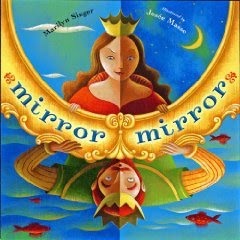 Mirror Mirror: a book of reversible verse by Marilyn Singer, illustrated by Josée MasseDutton Children's Books, 2010Fairy tales are told from two perspectives using the same poem, but read in reverse the second time. Deceptively simple premise, yes? Well, Marilyn Singer has come up with over a dozen pairs of poems that tell parts of fairy tales using the same words and the same lines, in a style she calls reverso. In her words: "When you read a reverso down, it is one poem. When you read it up, with changes allowed only in punctuation and capitalization it is a different poem" (last page of unpaginated book). Amazingly, it really works. I'm glad I read this book today for a second time, because when I read it for the first time last week I wasn't a huge fan of it: it struck me as gimmicky and some of the poems felt awkward. I must have been tired or in a foul mood because today I really enjoyed it. Admittedly, some of the poems don't flow as nicely as I would have liked, but when it clicks all is well in the world. My favourites of the 14 reverso pairs are The Doubtful Duckling and Longing for Beauty, both of which deal with the characters' emotions (the Ugly Duckling and Beauty and the Beast, respectively) as opposed to a description of events. In fact, the reversos in the book generally fall into one of those two categories: description of events and description of characters' feelings. Overall, I felt the ones that addressed emotions were more effective, but that may be my own bias. I must comment on the illustrations by Josée Masse because they are, in a word, spectacular. Each illustration is divided into two to reflect the reverso poems on the opposite page, and Masse creates beautiful links between each pair of illustrations. For example, Sleeping Beauty's skirt blends perfectly into the hills being climbed by the prince coming to save her. The illustrations are luminous, full of rich golds and greens and reds, and combine perfectly with the poems. For young students interested in poetry or fairy tales, this book will open their eyes to a challenging and fun style of writing.
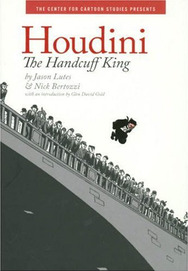 Houdini: the handcuff king by Jason Lutes & Nick BertozziThe Centre for Cartoon Studies, 2007It is 5:00am on May 1, 1908, and Harry Houdini is preparing for a handcuffed jump off of Harvard Bridge in Cambridge, Massachusetts. He checks the police-issued handcuffs, goes for a jog, and reviews the stunt plan with the police and his assistant. With the river almost freezing over and a large crowd expected, Houdini has his livelihood as well as his life at stake. The handcuff king is from the same publisher as my earlier-reviewed Amelia Earhart: this broad ocean, and it bears some striking similarities. Three colours are used in the drawings - in this case black, white, and a grey-blue - and there is a lengthy introduction by Glen David Gold, who wrote a biography about one of Houdini's contemporaries. Also, at the end of the book, there are more than four pages that provide supplementary details about specific panels in the book, from how the locks of the early 20th century worked to promotion and advertising during that time period. In fact, the back matter provides the context needed for this very brief glimpse into Houdini's life. The entire book spans the events of one day , and one stunt, in Houdini's career. It is a snapshot of the man he was, from his adoration of his wife Bess to the control he had over every single aspect of a performance, and an indication of his ability to attract huge crowds to his spectacles. The illustrations were detailed, particularly the crowd scenes, although I found the lettering style distracting. My favourite part of the book was when Houdini is struggling to escape from the handcuffs while underwater, which is shown on the panels at the edge of each page, and the reactions of the crowd and the ticking clock is shown in inner panels. It gives a distinct atmosphere of concurrent events and certainly increased the tension of the moment for me, and I appreciate how the Lutes and Bertozzi take this life-threatening stunt that would be a memorable event in most people's lives, and present it as a common occurrence in Houdini's life. The handcuff king is an accessible introduction to the life of a man that holds mystique for many, and in a format that students will be drawn to and learn from.
|










 RSS Feed
RSS Feed